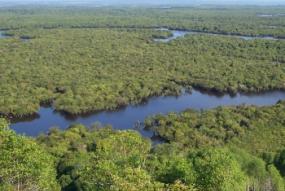
Invest in measurable change for our forests
Verified Impact (formerly Ecosystem Services Claims) is FSC’s evolving approach to monitoring, conservation, and improvement of ecosystem services in forests.
This upgraded system will help businesses, governments and forest managers access and disclose high-integrity forest data from FSC-certified forests. By investing in monitoring and improvement projects in FSC forests they unlock the data and stories needed to show their true forest impacts.
Verified Impact in action
Learn how the Huong Son State Forest Company is actively protecting and restoring the forest within Vietnam's Ha Tinh province, leveraging the benefits of FSC Verified Impact.
(Read the case study for more details about the project impacts on carbon sequestration)
Spanning 20,000 hectares of forest land, this region hosts a rich biodiversity of more than 2,300 plant and animal species. Thanks to its commitment, 727,425 tons of carbon dioxide (CO2) were successfully sequestered from the atmosphere during the period spanning from 2015 to 2020.
Discover the true value of forests
Healthy and resilient forests are often the unseen heroes in the battle against the climate and biodiversity crises. Forests regulate and stabilise our climate; they house vital ecosystems that are home to 80% of the world’s terrestrial biodiversity and provide the life support systems for hundreds of millions of Indigenous Peoples.
Without forests, we will lose the fight against climate change, diversity and social equality. However, the ecosystem services that forests provide are often overlooked. FSC provides data for five ecosystem services:
- carbon storage
- clean water
- healthy soil
- thriving biodiversity
- recreation.

Connecting forests, companies and climate action
The solution we are developing matches businesses, financial institutions, and governments to ecosystem-services projects in FSC-certified forests. These projects, run on the ground by forest managers, focus on monitoring, maintenance, and improvement of forests.
As a project sponsor, Verified Impact gives you access to credible, verified data around the real-world environmental and social impact that the project is having, so you can communicate this impact to your stakeholders.
Benefits for sponsoring organisations
-
Quantifiable data
-
Three layers of verification
-
Transparent, publicly available dashboard
-
Tailored and flexible
-
Data linked to your forest footprint
-
Socially responsible
FSC Verified Impact roadmap
1. Forest commitment
Forest managers commit to protect or restore a vital service provided by their forest. Ecosystem services include biodiversity preservation, carbon storage, water filtration, soil regeneration, and recreation opportunities. In collaboration with FSC and third-party certification bodies, they collect scientific data verifying the impact of their efforts.
2. Sponsorship
Organizations like yours volunteer to sponsor forest managers and their initiatives. Many forest managers are smallholders, Indigenous communities, or public—private associations that need financial support to ensure the long-term viability of their projects.
3. Evidence
Your business receives clear, verifiable evidence quantifying the impact of your sponsorship.
4. Communication
Share your verified impact data. These results show your customers, employees, and investors that you’re backing up your sustainability promises with actions that make a measurable difference.
Find a forest project

France
Join forces with forest managers across France who are engaged in a variety of responsible forestry initiatives. Several sponsorship opportunities are available.
Project focus: biodiversity, carbon storage...

Germany
Help conserve municipal forests in the Upper Middle Rhine Valley, a UNESCO World Heritage site.
Project focus: biodiversity, carbon storage, water, recreation conservation

Indonesia
A joint initiative based on community and organizational collaboration is set to restore over 7,000ha of degraded forest land in East Kalimantan.